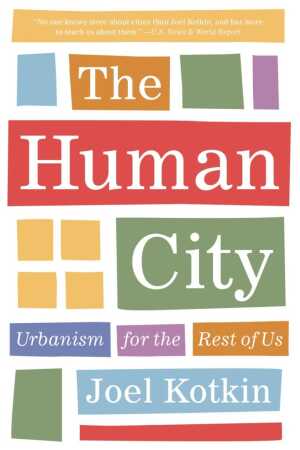The Human City: Urbanism for the Rest of Us
Joel Kotkin
AgateB2 Publishing
1328 Greenleaf Street, Evanston, IL
60202; www.agatepublishing.com.
2016. 312 pages. Cloth $24.95.
Joel Kotkin, a fellow in urban studies at Chapman University in Orange, California, whose previous works include The Next Hundred Million: America in 2050 and The New Class Conflict, in his latest book challenges the claimed advantages of high-density, “pack and stack” urban development. In The Human City, his gloves-off critique highlights the high housing costs, emphasis on childless singles or couples, and environmental impacts of city development according to the current conventional wisdom.
Contrary to the prevailing view of “retro-urbanists” and city planners, Kotkin advocates a blend of suburbs and city centers—what he terms the “human” or “dispersed” city. He regards the oft-maligned suburb as a necessary and practical place where affordable housing, family amenities, and nature come together to allow enjoyable middle-class living.
His book is a prolonged argument for development that responds to what people want and need during the course of their lives. Young professionals are attracted to the vitality and opportunity offered by high-intensity urban cores; in middle age, however, they seek the larger houses and greener surroundings of outlying suburbs.
For Kotkin, sprawl is not the enemy—an idea heretical to most of today’s urban gurus. He insists that dispersed suburban development makes possible the development of neighborhoods of detached houses—the linchpin of middle-class economics and defined by the largest asset of most households, their home.
In contrast, the mega-city attracts the well-educated and affluent elites, who live in high-rise luxury cores and are maintained by a poorer service class. The result is a geography of inequality, made up of rich residents and poor residents and accompanied by a declining number of jobs and decreasing housing affordability for the middle class.
Kotkin argues that these core cities, with their low birthrates and high level of income inequality, are not sustainable over the long run. But “few planners and powerful urban land interests” seem to comprehend these demographics when pushing policies that discourage suburban development in favor of dense and profitable urban transit nodes, he writes.
Kotkin spares no one. New urbanists are scorned for romanticizing the urban squares of crowded medieval cities without considering what it is like to live in such tight quarters. “Starchitects” are chastised for designing luxury skyscrapers for the elite without considering how to relieve the squalor of poor neighborhoods. Urban planners are frowned upon for proposing top-down urban growth boundaries without considering their impact on housing prices.
Despite its attack on contemporary urbanist ideology, The Human City acknowledges that urban areas need dense city centers. But it holds that the centers must be supported with diverse suburbs and exurbs—the natural products of urban growth. And these dispersed areas can be designed to create job-rich, family-friendly, and affordable smaller cities, such as the Woodlands, Texas; Reston, Virginia; Columbia, Maryland; Irvine, California; and the Borough of Milton Keynes in England.
The book’s scope is wide ranging. Cases are described in Japan, Australia, and India, as well as the United States. Kotkin was inspired to write the book while working in Singapore, where he observed that high-density living and enormous career pressures were producing high levels of anxiety and breaking down the familial culture.
The Human City is not meant as an anti-urbanist tract, but rather as a redefinition of urbanism to fit modern realities and the needs of families. The goal is to expand options for a better life by creating communities that people prefer and can afford. It’s hard to argue with that point.
David R. Godschalk is planning professor emeritus at the University of North Carolina at Chapel Hill and coauthor of Sustaining Places: Best Practices for Comprehensive Plans (APA Planning Advisory Service, 2015).





